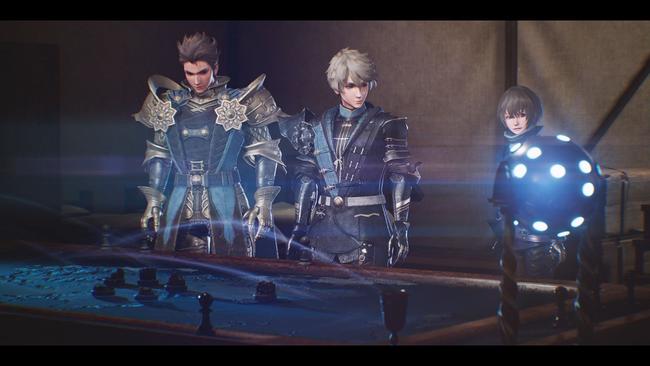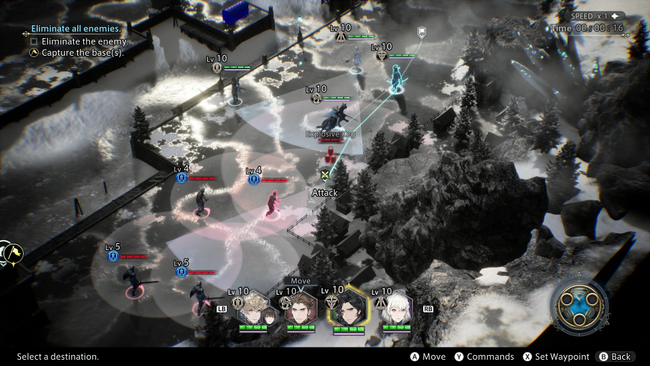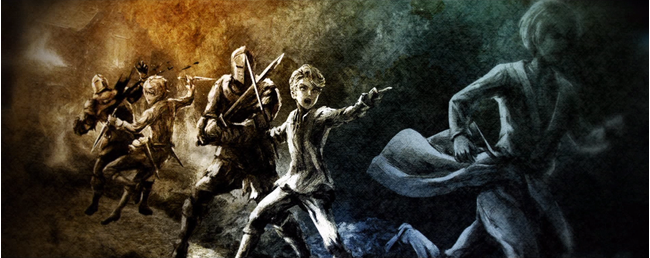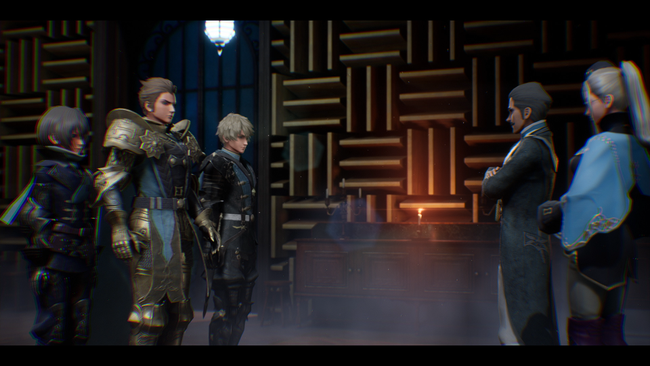
The DioField Chronicle Review
Nobody expected a game like The DioField Chronicle before its surprise announcement at a PlayStation State of Play earlier this year. Square Enix has a lot of IP under its belt, with several beloved franchises sitting dormant amidst fans' longing for reboots, revivals, or sequels. DioField is, clearly, none of these things. In fact, DioField is not really much like anything else with Square Enix's name on it.
Let me set one thing straight. For about the first minute of DioField's debut trailer back in March, you might get the impression the game is akin to Final Fantasy Tactics with its medieval setting, a backdrop of war & political strife, and the SQUARE ENIX branding. After seeing the first bit of gameplay, though, it's quite evident that The DioField Chronicle is not much like Final Fantasy Tactics at all, at least in how it plays. Truth be told, the narrative elements don't really emulate FFT either.
As it turns out, probably the best attribute of The DioField Chronicle is how unique it is as a whole, and how refreshing it feels compared to its many modern RPG contemporaries.

To set the stage, we are introduced to the main characters of The DioField Chronicle - Andrias Rhondarson & Fredret Lester - who as children befriend Levantia Shaytham, the 4th prince of Alletain and 2nd-in-line to the throne. Many years after a tragic event in their childhood, Rias and Fred (as they like to call each other) employ themselves as mercenaries and soon join a unit known as the Blue Foxes. The DioField Chronicle recounts the undertakings of the Blue Foxes during a turbulent time in Alletain's history.
Developed by Lancarse, The DioField Chronicle is probably best defined as a strategy RPG, but it doesn't use a tactical grid commonly found in the genre. You instead control a squad of four units in real-time, moving them with an isometric camera angle in brief skirmishes. When you encounter enemies in these stages, your squad will begin to attack - still in real-time - until you pause the action to select a combat skill.
If anything, DioField plays more like a real-time-with-pause RPG like Baldur's Gate, or you can even draw comparisons to RTS or MOBA titles. There is a lot of start-and-stop to the game, as you'll constantly be selecting units to move and actions to take, all of which will pause the action for each of these decisions. It may sound troublesome on paper, but once you get familiar with your squad and their abilities, your expeditions out onto the field become will become quite fluid in motion, and you'll soon master navigating your team through numerous missions.

Along with your four main units, each can also be accompanied by a supporting 'adjutant', meaning that eight units can be present in any one skirmish, at least in some form. These adjutants don't participate in combat directly, but they do offer an additional set of skills added to your team composition. With unit capability ranging from defensive efforts, to status-altering magic, to pure damage dealing and otherwise, there's a fair amount of flexibility in play despite the small team size.
In general, DioField's narrow budget is apparent, but not always in an unfavorable way. Many story scenes are not told through fully choreographed cutscenes with elaborate character models, settings, and animations. Instead, much of the game's narrative is told through almost comic-like illustrations, or through summaries given by the articulate narrator in between missions.
I can't deny it, in a way I actually prefer this stylistic approach over traditional cinematics, especially if budget constraints would only bring relatively simple scene direction otherwise. Of course, DioField's art style alone is fantastic and does a lot of heavy lifting - with DioField brought to life by a mix of artists such as Isamu Kamikokuryo and Taiki.

DioField's style of storytelling is a bit of a contrast to what some may have come to expect from modern RPG narratives. To put it succinctly, everything from exposition to character interaction is delivered in a somewhat abbreviated fashion. Events move at a brisk pace, characters are often quick and to-the-point, and no single development lingers for too long before the narrative shifts to the next one. Dialogue can feel terse, and I mean that in the best way possible. No words are wasted on characters circularly explaining the plot to each other. For someone like me, with an allergy to overwrought exposition, I greatly appreciated this.
In a way, "The DioFIeld Chronicle" is a very appropriate title for the game and is emblematic of DioField's method of storytelling. DioField often offers a historically-tinged account of a lengthy series of events that happens not only to the Blue Foxes, but to their resident country of Alletain as a whole, as though it was a record of past events. Some major, narrative-turning events are only given a few descriptive lines, because they don't need more than that. Some people & places important to the in-game lore are only mentioned by proper name once, and never again, because they don't need to be. On many occasions, DioField gives you exactly what you need to know, and not much more than that, which leaves some of the narrative nuances to be found between the lines.
Even with a relatively short runtime of fewer than 30 hours, quite a lot happens within DioField's narrative. From assassination attempts to coastal invasions to episcopal conspiracies and democratic uprisings, DioField's storyline is always moving along with its chronicling style. Even the game's mission design likes to keep things bite-sized, with most excursions doable in just a few minutes. However, not only is DioField narratively and mechanically refreshing, but its composition ultimately progresses in a way that is quite bold for the genre, and it certainly doesn't play it safe with its narrative design. I think the game's ending is a perfect encapsulation of this, personally. Of course, I can't share more specific details on that here.

Despite my adoration for some of its stylistic elements and design choices, DioField has plenty of shortcomings. If I had to grade The DioField Chronicle on some hypothetical rubric, there are plenty of places where I could feasibly 'dock points', if you will. The character models and animations are quite basic. The missions are all kind of short and samey. The sidequests are somewhat cookie-cutter and forgettable. The skill selection isn't very balanced. The enemy variety is severely lacking. Character building is rather streamlined. There's a base-building mechanic, but it's relatively barebones and arguably a glorified menu.
So, depending on what exactly you are looking for in a strategy RPG, DioField may not be the game to suit your needs. It's more of an unorthodox experimental tactical RPG than a traditional grandiose epic. It helps to approach Diofield with proper expectations, I think, to appreciate the game for what it is -- though Square Enix certainly didn't do a great job promoting their new IP to begin with.
The DioField Chronicle is also an easy game, at least on its default difficulty settings. As you make your way through DioField, you'll inevitably develop your preferred party with some skill loadout becoming an 'engine' that'll likely decimate everything the game throws at you. I didn't mind this much personally, as it wasn't a sense of challenge that endeared me to DioField's mechanics. Instead, it was the desire to create as efficient and powerful a skill rotation as possible. I enjoyed theory-crafting party builds and skill combinations that would completely bulldoze any enemy formation. There is a harder difficulty option available, for those looking for a more challenging experience, but I relished creating my unbeatable lineup instead.
I typically don't comment on these sorts of things, but I want to give special mention to DioField's user interface. In a game that's relatively dense with mechanics, units, skills, and items all requiring descriptions & details, I felt that DioField does an admirable job in organizing all these things for the player. The font is very legible, icons & colors are well-implemented, and the use of colors make navigating DioField's many menus actually somewhat pleasant. Even the UI animations and sound effects are all very satisfying, as much as UIs can be, I suppose. Even the game's keyboard and mouse controls are quite intuitive to use and perfectly suited to this style of game. I also have to give props to the work done by Side UK, who did an exceptional job with The DioField Chronicle's English voice work and direction. The musical score by Ramin Djawadi and Brandon Campbell also fits the game perfectly, too.
Despite its various shortcomings, I came away from The DioField Chronicle satisfied with its uniquely refreshing take on strategy RPGs. DioField's storytelling style was specifically a highlight for me, and its take on tactical combat offers something different from its contemporaries. While its mission design, sidequest variety, and some skill systems hold it back, DioField is worth a try for anyone looking for something just a bit different in their tactical RPGs.